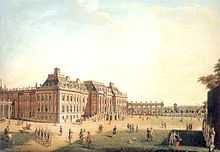City Palace, Potsdam


The City Palace (German: Potsdamer Stadtschloss) was a historical building in Potsdam, Germany. It was the second official residence (the winter residence) of the margraves and electors of Brandenburg, later kings in Prussia, kings of Prussia and German emperors. The original building stood on the Old Market in Potsdam, next to the Church of St. Nicholas (Nikolaikirche) and the Old Townhall.
The partial reconstruction with a historic facade including numerous original components and a modern interior was completed in late 2013. The building will serve as the new parliament house of the federal state of Brandenburg from 2014 on.[1]
History
The baroque palace was constructed on the site of an earlier fortification from 1662 to 1669 under Kurfürst Friedrich Wilhelm, and was rebuilt by Georg Wenzeslaus von Knobelsdorff under Friedrich II from 1744 to 1752, who performed additional interior decoration. It stood as one of the most important examples of Frederician Rococo.
During an allied bombing attack on 14 April 1945 the City Palace was bombed and burned out, some parts of the main walls remained. The communist party (official name: Socialist Unity Party of Germany, SED) decided to remove the ruin in 1960. The formerly cohesive New Market lost its face. The only building of the castle that was left standing was the stables, in which today the Potsdam Museum of Film can be found. In 1991 it was attempted to build a new theatre on the site of the City Palace, but this failed as it would have obstructed the view of the Church of St Nikolai. Only the skeleton of the building had gone up before it was torn down.
Reconstruction
From 2000 to 2002 the Fortuna Gate of the castle was rebuilt on the Old Market, funded by, among others, the donations of Günther Jauch. During the preliminary ground analysis old vases and other artifacts were dug up, and even parts of the old fortifications were excavated. As the erection of a protective roof would have been too expensive, the resulting hole was filled in again at the end of the summer of 2000. 2004 began with the laying of wires around the area of the City Palace. In the process the Old Market was lowered to its old height (about 46 cm deeper) and paved with granite. On the day of German unity the work was finished at a cost of 10 million euros, whereupon the neighbouring buildings received new stairs (the Nikolai Church had lost its Schinkel Stairs).
The reconstructed City Palace will be the future home of the state government (Landtag) of the federal state of Brandenburg.
-

The Potsdam City Palace in 1928
-

In ruins after WWII
-

The remaining stables in 2005
-

View over the empty Old Market in 2007 with the reconstructed Fortuna Gate

On the 20th May the Landtag of Brandenburg decided to rebuild the Potsdam City Palace in its historical form by 2011. Constructions are planned to begin in 2010, old sections would be rebuilt. The Landtag parliament would then occupy the inside. The cost for the project was put at 120 million euros, of which the actual building would take 80 million, with the remaining 40 million being spent on the rebuilding of the crossroads and the façade. A private investor offered to pay for the building of the palace so long as he could build a shopping centre next to it, but this was not acceptable. A heated argument broke out over whether a new tram bridge should be built to solve the traffic problem (at a cost of €10m), supposedly because the tram lines would otherwise not come by the palace.
Since 16 February 2006 a new plan has been put forward. Under this the City Palace would only retain the northern side of its historic façade. The side wings have 5 tiers instead of the original 3, so another façade would be built there. The southern façade would be built in a more modern fashion, without the approach, and in this part of the building would contain the plenar hall. The advantage would be that the inner courtyard would remain and could be used for future events. The Landtag would still move into the building as before, although the castle would be rebuilt according to its historical layout. In November 2007 Hasso Plattner donated additional 20 million Euro to rebuild the outer facade with its historic details.
References
External links
| Wikimedia Commons has media related to Stadtschloss Potsdam. |
| |||||
- 'Das Potsdamer Stadtschloss in Gefahr' (1949), historical short movie about Potsdam city palace warning against its demolition.
Coordinates: 52°23′41″N 13°03′38″E / 52.39472°N 13.06056°E